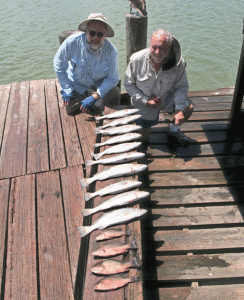
Fishing in the bays and at the jetties is good and getting better as things heat up. Live shrimp and lures have been taking limits of trout, scattered reds and mangrove snapper. These fishermen caught these while fishing with Capt. Robert Sloan and Lucky Strike Guide charters. For details call 409 782 6796, email – sloan288@aol.com or check out www.luckystrikeguide.com. Robert Sloan photo.
Red snapper fishing is as good as it’s ever been over wrecks, rocks and rigs out of Port O’Connor, but even with stringent regulations there are still some major issues that recreational anglers have to deal with.
The National Marine Fisheries Service recently released a report on the Fisheries Economics of the United States. It’s almost comical to compare the amount of money generated by recreational anglers as compared to commercial fishing. The report was posted by Brad Gentner, president of Gentner Consulting Group.
According to the FEUS report, in 2015, the fisheries economy in the US generated $200 billion in total economic activity. Of that number, $13.9 billion was created by the commercial sector; $38.0 billion from the supply chain all the way to the consumer for those fish caught by US commercial harvesters; $92.3 billion in seafood imports and $63.4 billion from recreational fishing. That’s $63.4 billion recreational vs. $13.9 billion for the commercial harvesting sector.
“NMFS did not try once again to paint the commercial industry as larger than the recreational industry in its announcement,” says Gentner. “That only makes sense because the commercial industry has a smaller economic footprint no matter how you slice it.
“Even in the face of increasingly harsh regulations forcing recreational fishing effort down nation-wide, spending by recreational anglers has stayed strong, even increasing. 2015 was up almost $3 billion dollars over 2014, mainly due to a revised durable good expenditure survey that showed recreational anglers are, on average, spending more per person on durable goods like boats and rods and reels. It is likely that trip expenditure estimates will go up even further for 2016 as a new trip expenditure survey has recently concluded.”
Meanwhile commercial fishing is shrinking, with revenue dropping more than $300 million from 2014 to 2015 and total economic activity dropping by nearly $10 billion dollars during the same time frame.
“If the recreational sector produces nearly $12 billion a year more than the entire seafood supply chain from the commercial harvester to the consumer, and nearly $50 billion more than the commercial sector, the inevitable question is, why does NOAA Fisheries spend the bulk of its time, effort and energy on management of the commercial harvesting sector?” said Gentner.
“The federal government has routinely ignored even its own economic reports that show recreational fishing generates drastically more economic activity with a lighter impact on the environment and on marine resources. As a nation, we are missing a tremendous economic opportunity when the agency charged with managing the nation’s fisheries operates in such a one-sided and completely illogical manner. “
The good news is that red snapper fishing has been reopened for private recreational anglers in the Gulf out to 200 miles every Friday, Saturday and Sunday, including the Monday of Labor Day.
As of now the red snapper harvest is closed in state and federal waters Monday through Thursday each week except on the days noted above surrounding national holidays. Texas state waters will then remain open for the duration of the fall season starting Sept. 5.
“The federal fisheries management system is failing recreational anglers on many levels, and the red snapper is the “poster fish” of the quagmire,” said Jeff Angers, President of the Center for Sportfishing. “The temporary rule directly addresses this problem, giving recreational anglers an opportunity to enjoy America’s natural resources and giving the Gulf economy a much-needed shot in the arm.
“ The new regs would not be possible without the tireless work of Commerce Secretary Wilbur Ross. Industry leaders met with Secretary Ross in March, and he listened. We also thank Majority Whip Steve Scalise (R-La.), Congressmen Garret Graves (R-La.) and Austin Scott (R-Ga.) for beginning the conversation with the Trump Administration in March regarding the mistreatment of private recreational anglers. The status quo in federal fisheries management driven by radical environmentalists is a man-made fishery management disaster.”
While private recreational anglers – those who purchased a boat, fishing gear, fishing license, fuel, ice, etc. – were originally limited to a three-day red snapper season in federal waters this year, charter boat operators were granted a 49-day season and commercial fishermen were granted a 365-day season.
“People profiting from our public resources were gifted more access than the American public,” says Angers.
Now that’s off the charts crazy!
